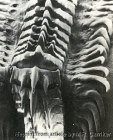|

Home
About Barnegat
Bay
History
Wampum
Shellfish
Clams
Oysters
Crabs
Mussels
Scallops
Snails
Shrimp
Whelks
Environment
Glossary
Links to Barnegat Bay Webites
Links
to Useful Websites
About Us |
|
Gastropod Radula
|
|
Radula
Radula Details
Snails |
|
Radula specific to
snails (from Latin radere - to
scrape) |
|
 Most
Mollusks (with the exception of bivalves) have a
specialized feeding organ within the mouth
called the radula. Most
Mollusks (with the exception of bivalves) have a
specialized feeding organ within the mouth
called the radula.
The mouth opens
into a pocket-like
buccal cavity. Inside this cavity is
the radula sac which protects the mouth when the
radula is not in use.
Supporting the
radula is a structure of cartilage called the
odontophore.
Controlled by muscles, it is capable of being
thrust forward and retracted in a rhythmic
motion for feeding and retracted when finished.
As for the radula
itself. it is a ribbon-like structure covered
with many denticles (tiny teeth). It is movable
over the odontophore and is also controlled by
muscles. |
|
<click here for Radula
details> |
|
As the snail
feeds, these actions continually wear down the
frontal teeth. New teeth are continuously formed
at the posterior end of the buccal cavity in the
radula sac. They are slowly brought forward to
the tip by a slow forward movement of the
ribbon, to be replaced in their turn when they
are worn out |
|
Fun Fact - The teeth (denticles) of the
radula consist of the same material as the
exoskeleton
|
|
The feeding
behavior of marine snails include some that are
herbivores,
detritus (debris)
feeders, scavengers and predatory
carnivores.
Herbivores use
radula is used in two main ways:
- as a "rake" to
comb up microscopic algae from a surface such as
a rock (or side of a fish tank)
- as a "rasp" to
break away small pieces when feeding on a plant |
|
 The array of horny
teeth shown to the right belong to the radula of the Oyster
Drill, a member of the
Murex family noted for boring drill holes
into heavy shells of mussels and other mollusks. The array of horny
teeth shown to the right belong to the radula of the Oyster
Drill, a member of the
Murex family noted for boring drill holes
into heavy shells of mussels and other mollusks.
The left and right ranks of teeth are
hooked, and the middle tooth shows three cusps.
Like all gastropods, the radular teeth are
continually renewed from top to bottom, as they
are worn away. In the case of the oyster drill,
rather than depending on silicon- or
iron-hardened radular cusps, drilling is
facilitated by secretions of an accessory
salivary gland used to soften shell materials.
<click on image to enlarge> |
|
